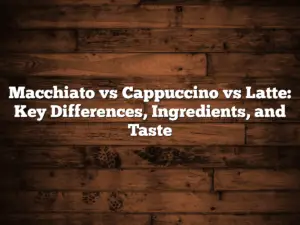As an Amazon Associate CoffeeXplore.com earns from qualifying purchases.
What is a Cappuccino?- Coffee Drink
Ever wondered, “What is a cappuccino?” as you sip the frothy coffee concoction at your favorite café?
As a coffee enthusiast, you may be eager to explore the classic cappuccino in-depth, seeking a greater understanding of its components, preparation methods, and variations. Maybe you’re even intrigued by its rich cultural history and origins.
What is a cappuccino? A cappuccino is a popular espresso-based coffee drink made with steamed milk and milk foam, originating from Italy.
In this comprehensive guide, I’ll share my expertise on cappuccinos, uncovering the details behind the beloved drink, the ingredients that create its rich and velvety taste, and its fascinating history. Additionally, I’ll guide you through cappuccino preparation and its many variations, so you can enjoy the perfect cappuccino every time. So, sit back, grab your favorite coffee, and let’s begin our journey into the world of cappuccinos!
Key Facts:
- A cappuccino is a popular coffee drink made with espresso, steamed milk, and milk foam.
- Traditional cappuccinos have a ratio of one part espresso, one part steamed milk, and one part milk foam.
- The term “cappuccino” comes from the Capuchin friars and refers to the color of their habits.
- Cappuccinos originated in Italy in the late 1900s. (Source: Team Research)
- Variations of cappuccino can include using cream instead of milk, non-dairy milk substitutes, and flavorings like cinnamon or chocolate powder.
What is a Cappuccino?
A cappuccino is a well-loved coffee drink, characterized by its rich aroma and delicate balance of three main ingredients: espresso, steamed milk, and milk foam. The traditional cappuccino combines equal parts of these ingredients, creating a harmony of flavors and textures that have won over coffee connoisseurs worldwide.

Traditional vs. Modern Cappuccino
While the traditional cappuccino consists of a tried-and-true ratio that still maintains its popularity today, many modern cappuccino versions have emerged, adjusting the balance of espresso, milk, and foam to meet individual tastes. As a result, coffee enthusiasts can explore the wide range of regional and personal preferences that cappuccinos have to offer.
The History and Origin of Cappuccinos
Cappuccinos have a storied history that traces back to Italy in the late 1900s. With the rise of espresso machines, baristas had new tools to create the beloved frothy, creamy coffee experience we know today. Named after the Capuchin friars, the cappuccino’s distinct color resembles the friars’ characteristic brown habits. Over time, this Italian classic has evolved and spread, leaving its mark on the global coffee culture.
The Impact of Cappuccinos on Coffee Culture
The cappuccino has had a significant impact on coffee culture, becoming a standard of quality for espresso-based drinks and an essential part of the everyday coffee experience for many people. As a result, its influence has sparked various trends and innovations in the coffee world, including latte art, unique brewing methods, and variations that cater to different tastes.
Ingredients of a Cappuccino
The magic of a cappuccino lies in its three key ingredients that work in harmony: espresso, steamed milk, and milk foam.
Espresso
Espresso is the foundation of a cappuccino, providing the robust and intense coffee flavor that sets the stage for the delicate balance of the drink. As an espresso-based beverage, the quality of your cappuccino is only as good as the espresso you use.
Steamed Milk
Steamed milk adds a creamy, velvety texture to the cappuccino, lending a rich taste and complementing the espresso’s intensity. When added to the espresso, steamed milk smooths out the coffee’s bold flavor and balances its acidity.
Milk Foam
Milk foam is the unsung hero of the cappuccino, providing the drink with its unique airy texture and gentle sweetness. This layer of frothed milk captures the essence of the cappuccino and makes it visually distinct from other coffee drinks.
Ratio: The Perfect Balance
Achieving the perfect harmony of espresso, steamed milk, and milk foam is vital to crafting a great cappuccino. The traditional cappuccino employs a 1:1:1 ratio — one part espresso, one part steamed milk, and one part milk foam. However, modern variations may adjust this ratio to better suit individual palates and preferences.
How to Make a Cappuccino at Home
Believe it or not, you can create the perfect cappuccino experience right in your kitchen. To do so, you’ll need to follow these steps:
Choosing the Right Equipment
To make a cappuccino at home, you’ll need an espresso machine or a compatible coffee maker that can produce espresso. You’ll also need a milk frother or steam wand to create the steamed milk and milk foam.
Brewing Espresso Perfectly
Begin by brewing a perfect shot of espresso, using freshly ground coffee beans and an espresso machine or coffee maker. Aim for about 30 ml (1 ounce) of espresso per cappuccino.
Creating Steamed Milk and Milk Foam
Next, pour cold milk into a frothing pitcher, stopping at the lower third of the jug. Using a milk frother or the steam wand of your espresso machine, heat the milk while gently incorporating air to create steamed milk and milk foam. Be sure to pay attention to the temperature, aiming for around 150°F (65°C).
Assembling Your Cappuccino
Finally, pour the steamed milk over the espresso in your cup, followed by scooping the milk foam on top. As a finishing touch, you can sprinkle a pinch of chocolate or cinnamon powder over the foam, and voilà — your homemade cappuccino is ready to enjoy!
Cappuccino Variations
Cappuccinos come in various forms, catering to different tastes and preferences. Some popular cappuccino variations include:
Flavoring Options: Cinnamon and Chocolate Powder
For a little extra flair, many people enjoy adding a sprinkle of cinnamon or chocolate powder to their cappuccinos. These flavorings can enhance the taste and offer a delightful twist on the classic drink.
Non-Dairy Milk Substitutes
Cappuccinos can be made with non-dairy milk alternatives like almond, soy, or oat milk. These substitutes can offer unique flavors and textures while catering to dietary needs or preferences.
Cream-Based Cappuccinos
In some regions, cappuccinos are made using cream instead of milk, offering a thicker and more luxurious texture while still maintaining the same frothy and foamy appearance.
Iced Cappuccinos
For a refreshing twist, iced cappuccinos combine the essential components of a cappuccino with cold milk and ice, creating a chilled beverage perfect for warm days.
Comparisons: Cappuccino vs Other Popular Coffee Drinks
As a coffee enthusiast, you might be wondering how cappuccinos differ from other popular espresso-based coffee drinks such as lattes, macchiatos, and flat whites. Here’s a quick comparison.
Latte
Lattes are similar to cappuccinos but with a higher milk-to-espresso ratio, making them creamier and milder in taste. Lattes often feature latte art, witnessed as intricate designs etched into the milk foam using a barista’s skilled hand.
Macchiato
A macchiato is a more potent coffee drink made by pouring a small amount of milk foam over a shot of espresso. The result is a bold and intense coffee with just a touch of creamy sweetness.
Flat White
A flat white is a popular Australian espresso drink made with a double shot of espresso and steamed milk. Unlike a cappuccino, a flat white lacks a thick layer of milk foam and has a slightly higher milk-to-espresso ratio, resulting in a smoother and creamier coffee.
Health Benefits and Nutritional Information
Potential Benefits
Cappuccinos offer several health benefits, primarily due to their key ingredients of espresso and milk. Some potential benefits include antioxidants from coffee, improved cognitive function, and a reduced risk of certain diseases. Additionally, the calcium and protein present in milk can provide essential nutrients for overall health.
Side Effects or Limitations
However, it’s essential to note that cappuccinos can also have some drawbacks or limitations, such as increased calorie intake and potential adverse effects from overconsumption of caffeine. To enjoy cappuccinos responsibly, be mindful of your portion sizes and overall caffeine intake.
FAQs About Cappuccinos
What is the difference between a cappuccino and a latte?
A cappuccino has an equal ratio of espresso, steamed milk, and milk foam, while a latte has more milk and less foam, resulting in a creamier and milder flavor.
Is a cappuccino stronger than coffee?
Cappuccinos are espresso-based and can be stronger than drip coffee, as espresso is more concentrated and robust in flavor.
What makes a cappuccino different from coffee?
A cappuccino combines espresso with steamed milk and milk foam, creating a unique texture and flavor profile that differs from standard brewed coffee.
Is a cappuccino the same as a mocha?
A cappuccino and a mocha are both espresso-based drinks, but a mocha includes chocolate syrup, which adds a distinctive chocolaty flavor to the drink.
Summary
In conclusion, a cappuccino is a delightful espresso-based coffee drink made with steamed milk and milk foam, offering a diverse range of variations to suit different tastes. Developed in Italy and named after the Capuchin friars, cappuccinos have left a significant impact on coffee culture worldwide. By understanding the essential ingredients, preparation methods, and differences between cappuccinos and other popular coffee beverages, you’ll be well-equipped to enjoy the perfect cappuccino every time. So go ahead and pour yourself a cup of this classic coffee delight and appreciate its harmonious blend of flavors and textures.




